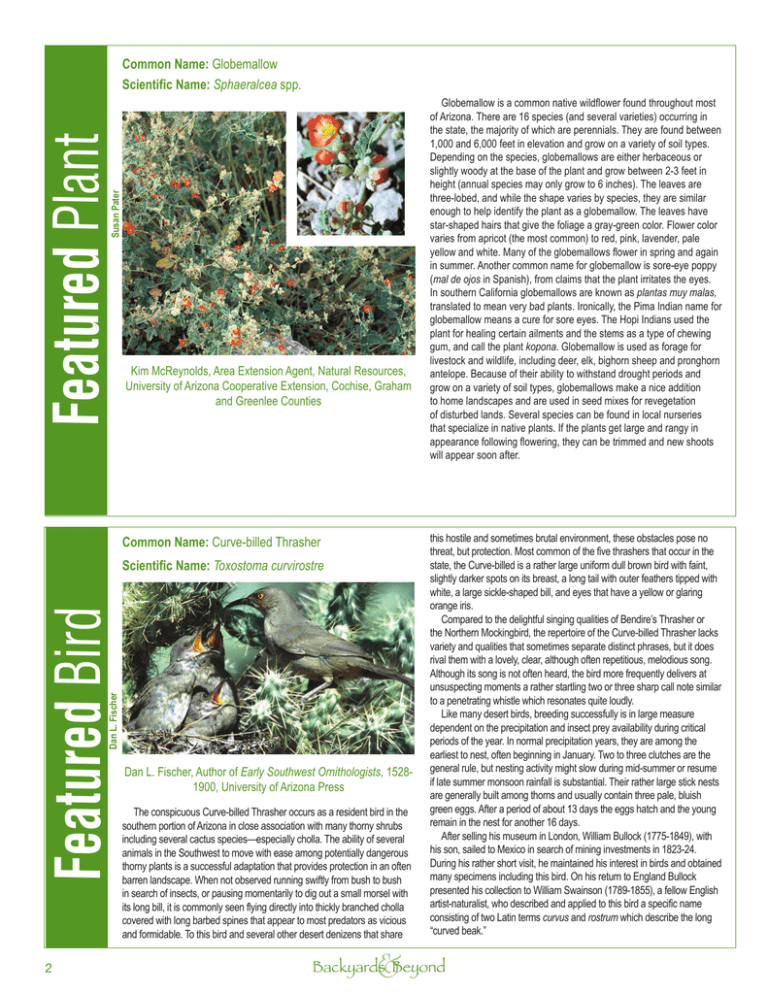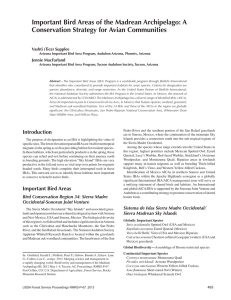Common Name: Scientific Name:
advertisement

Susan Pater Featured Plant Common Name: Globemallow Scientific Name: Sphaeralcea spp. Kim McReynolds, Area Extension Agent, Natural Resources, University of Arizona Cooperative Extension, Cochise, Graham and Greenlee Counties Common Name: Curve-billed Thrasher Dan L. Fischer Featured Bird Scientific Name: Toxostoma curvirostre 2 Dan L. Fischer, Author of Early Southwest Ornithologists, 15281900, University of Arizona Press The conspicuous Curve-billed Thrasher occurs as a resident bird in the southern portion of Arizona in close association with many thorny shrubs including several cactus species—especially cholla. The ability of several animals in the Southwest to move with ease among potentially dangerous thorny plants is a successful adaptation that provides protection in an often barren landscape. When not observed running swiftly from bush to bush in search of insects, or pausing momentarily to dig out a small morsel with its long bill, it is commonly seen flying directly into thickly branched cholla covered with long barbed spines that appear to most predators as vicious and formidable. To this bird and several other desert denizens that share & Globemallow is a common native wildflower found throughout most of Arizona. There are 16 species (and several varieties) occurring in the state, the majority of which are perennials. They are found between 1,000 and 6,000 feet in elevation and grow on a variety of soil types. Depending on the species, globemallows are either herbaceous or slightly woody at the base of the plant and grow between 2-3 feet in height (annual species may only grow to 6 inches). The leaves are three-lobed, and while the shape varies by species, they are similar enough to help identify the plant as a globemallow. The leaves have star-shaped hairs that give the foliage a gray-green color. Flower color varies from apricot (the most common) to red, pink, lavender, pale yellow and white. Many of the globemallows flower in spring and again in summer. Another common name for globemallow is sore-eye poppy (mal de ojos in Spanish), from claims that the plant irritates the eyes. In southern California globemallows are known as plantas muy malas, translated to mean very bad plants. Ironically, the Pima Indian name for globemallow means a cure for sore eyes. The Hopi Indians used the plant for healing certain ailments and the stems as a type of chewing gum, and call the plant kopona. Globemallow is used as forage for livestock and wildlife, including deer, elk, bighorn sheep and pronghorn antelope. Because of their ability to withstand drought periods and grow on a variety of soil types, globemallows make a nice addition to home landscapes and are used in seed mixes for revegetation of disturbed lands. Several species can be found in local nurseries that specialize in native plants. If the plants get large and rangy in appearance following flowering, they can be trimmed and new shoots will appear soon after. this hostile and sometimes brutal environment, these obstacles pose no threat, but protection. Most common of the five thrashers that occur in the state, the Curve-billed is a rather large uniform dull brown bird with faint, slightly darker spots on its breast, a long tail with outer feathers tipped with white, a large sickle-shaped bill, and eyes that have a yellow or glaring orange iris. Compared to the delightful singing qualities of Bendire’s Thrasher or the Northern Mockingbird, the repertoire of the Curve-billed Thrasher lacks variety and qualities that sometimes separate distinct phrases, but it does rival them with a lovely, clear, although often repetitious, melodious song. Although its song is not often heard, the bird more frequently delivers at unsuspecting moments a rather startling two or three sharp call note similar to a penetrating whistle which resonates quite loudly. Like many desert birds, breeding successfully is in large measure dependent on the precipitation and insect prey availability during critical periods of the year. In normal precipitation years, they are among the earliest to nest, often beginning in January. Two to three clutches are the general rule, but nesting activity might slow during mid-summer or resume if late summer monsoon rainfall is substantial. Their rather large stick nests are generally built among thorns and usually contain three pale, bluish green eggs. After a period of about 13 days the eggs hatch and the young remain in the nest for another 16 days. After selling his museum in London, William Bullock (1775-1849), with his son, sailed to Mexico in search of mining investments in 1823-24. During his rather short visit, he maintained his interest in birds and obtained many specimens including this bird. On his return to England Bullock presented his collection to William Swainson (1789-1855), a fellow English artist-naturalist, who described and applied to this bird a specific name consisting of two Latin terms curvus and rostrum which describe the long “curved beak.” Backyards Beyond




